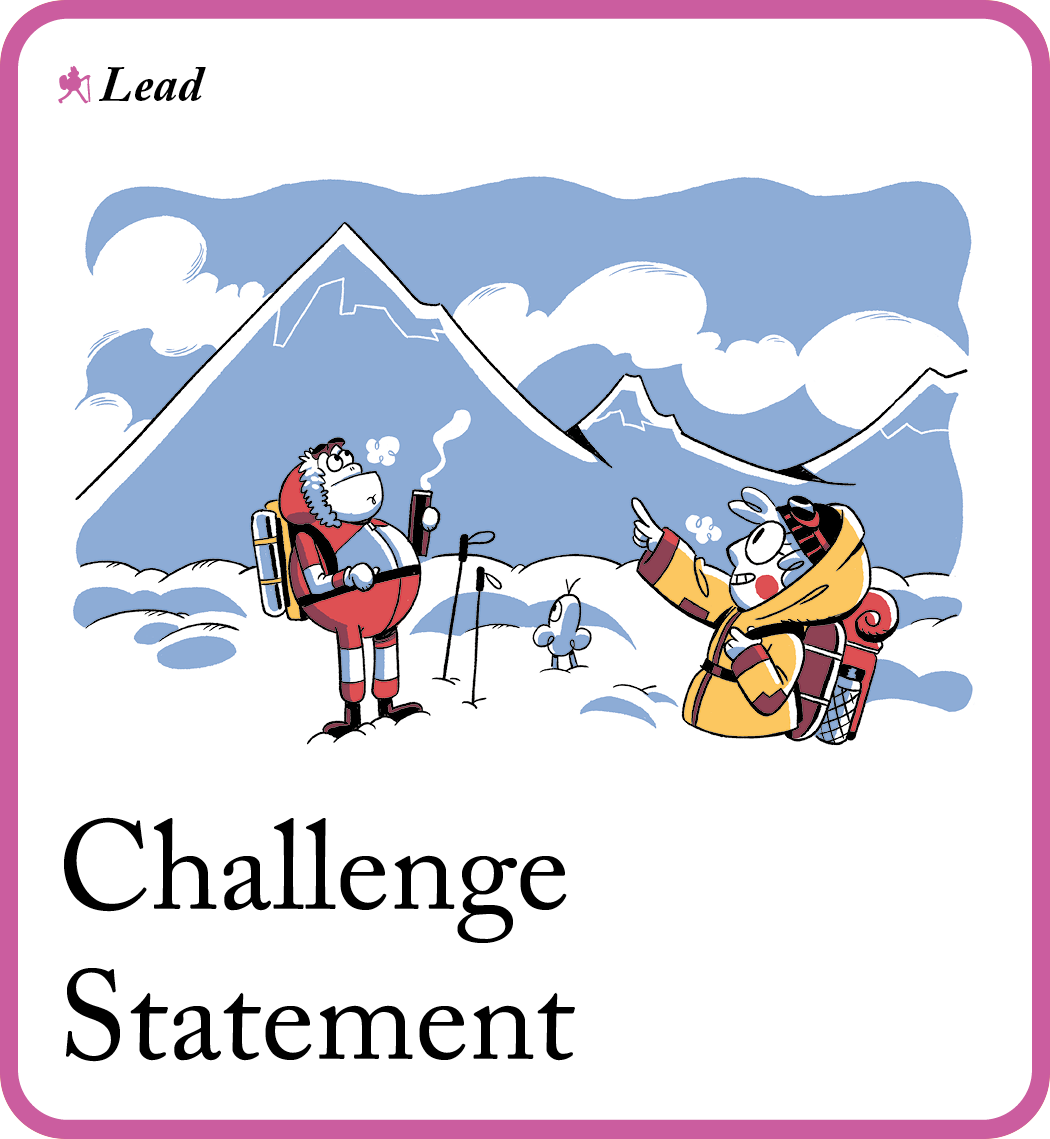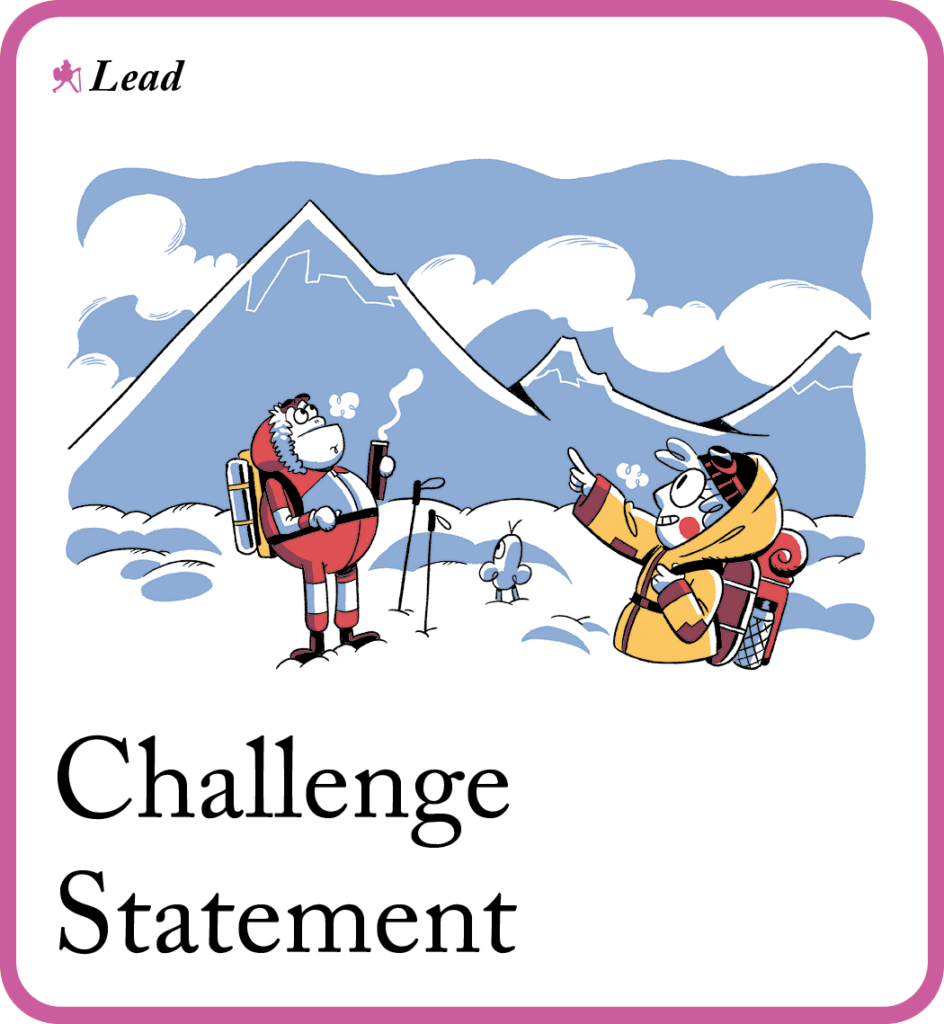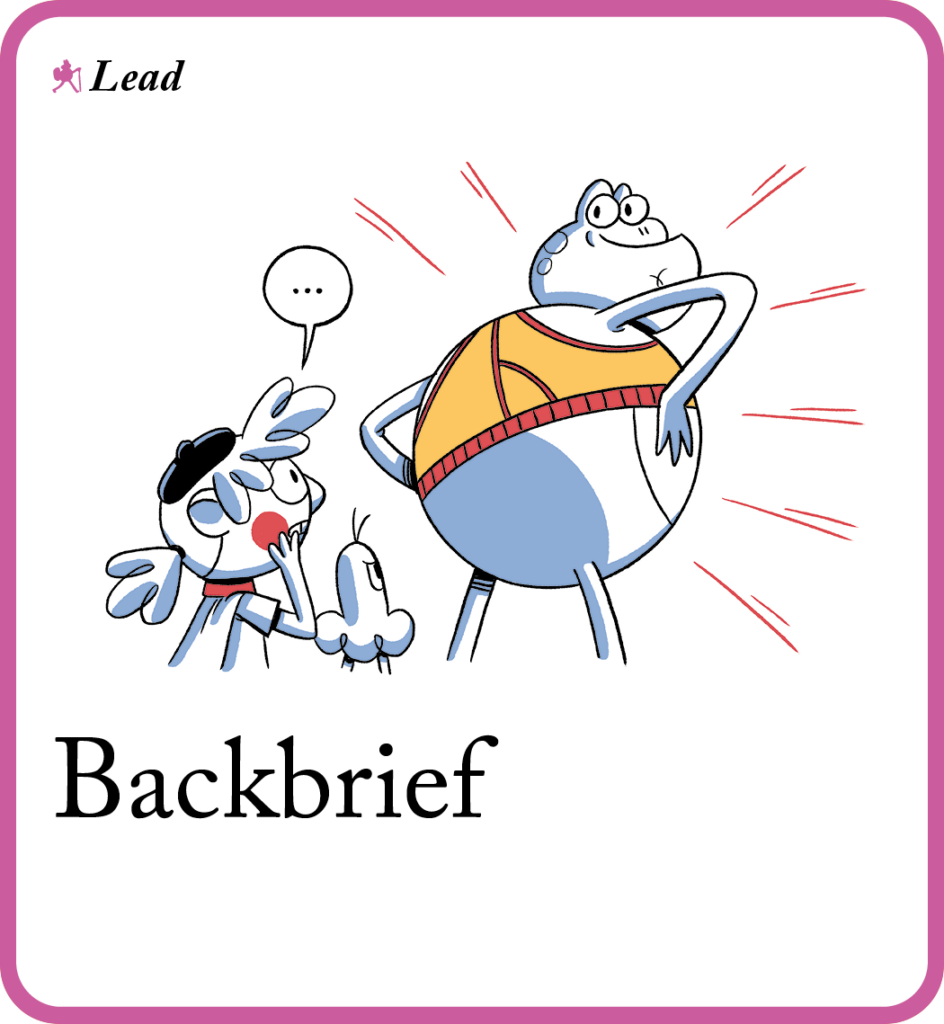Use these tactics
Let’s explore these tactics with an example: Pip’s Cafe
Pip’s Cafe must adapt to market changes, so the owner will unite the team to create and execute a new strategy. See below how Pip’s Cafe uses these tactics to solve their problem.
1
Use Give Me A Reason to paint a compelling future
Use Give Me A Reason to paint a compelling future

🧠 What’s the goal? Speak like a leader so that everyone stays connected to the purpose.
👀 Why is this important? While you can start with ‘why’, that’s not where you should finish. What do people need to believe in order for that ‘why’ to make sense? Help them see the world from your point of view, and then encourage them to make their own choices. Create a constant sense of purpose. Say it again and again until it’s alive in everyone’s work.
💡 Tip: practice this speech with a trusted group, gather feedback, and refine until your message is clear and impactful and ready to share with the team.
Instructions
1. On your own, draft a short but compelling speech that covers the following sections and can be delivered (or read) in just a few minutes:
a. Sum it up:
What is the situation we’re in?
Example: We are at a crucial point due to market changes, with Pip’s Cafe’s unique coffee and cozy vibe needing a strategic shift to stay competitive and keep customers happy.
What’s good about it?
Example: We have a strong brand and a passionate team, with our unique coffee and atmosphere as foundational strengths.
What’s bad about it?
Example: The evolving market threatens to outpace us if we don’t swiftly and effectively adapt.
How did we get here?
Example: Changes in consumer preferences and new market players have challenged our original model, putting us at this crossroads.
b. Describe the best possible future:
What vision of the world are we fighting for?
Example: We envision Pip’s Cafe as a community hub, transforming every coffee cup into an experience of joy and connection.
Why is that world right? (Why is it compelling?)
Example: This future aligns with our values of community, turning every visit into a moment of connection and belonging.
Double down: why is it morally outrageous that this world isn’t already here?
Example: It’s a moral failing that such inclusive spaces aren’t universally available, as they are essential in today’s isolating world.
c. Describe the worst possible future:
What vision of the world are we fighting against?
Example: We resist a future where Pip’s Cafe loses its identity, becoming indistinguishable and disconnected from our community.
Why is that world wrong?
Example: This future is wrong as it represents a loss of connection and identity, undermining our unique value.
Double down: why is it morally outrageous that this world might come to be?
Example: Allowing this to happen would mean betraying our community, team, and values, choosing complacency over connection.
⬇️ In the next tactic, you will take what you have written and add a call to action with Challenge Statement, before presenting it to your team.
2
Use Challenge Statement to define clear upcoming challenges
Use Challenge Statement to define clear upcoming challenges

🧠 What’s the goal? Eliminate miscommunication by crafting a crystal clear objective.
👀 Why is this important? People are not robots; they do not take orders. Instead, they make the best choices they can with whatever information they have. Your job, then, is not to issue instructions, but to make the challenge clear. Use this tactic to craft an objective and test it for clarity, so you can be sure it will be heard and understood.
💡 Tip: strive for simplicity and resonance in your Challenge Statement; it should encapsulate your vision in a way that’s easily understood and emotionally compelling, ensuring that every team member can see their role in the shared journey ahead.
Instructions
-
Use what you have from Give me a Reason and now you will add your Challenge Statement to the end of it. Write the first draft of your Challenge Statement, following this outline:
-
What outcome could we achieve if we tried?
Example: “By exploring new strategies, we could potentially expand our market reach, creating a more diverse customer base and increasing our overall impact in the industry.” -
Why does it matter, and what does it mean?
Example: “This matters because staying relevant ensures our survival and growth, meaning we continue to create cherished community spaces and job opportunities.” -
What sort of actions are explicitly off limits?
Example: “Compromising our quality or core values for quick profits is off limits; we won’t cut corners that could tarnish our brand’s integrity.” -
What sort of actions are explicitly encouraged?
Example: “We encourage creative ideas that enhance customer experience and operational efficiency, especially those that align with our mission of community and connection.” -
What will it look like if we succeed?
Example: “Success will look like a bustling cafe filled with satisfied customers, a motivated team, and a brand that resonates with our community’s spirit.”
Revise until it’s brief, simple and clear.
-
-
Gather your team and deliver your combined Give me a Reason and Challenge Statement to them. Speak boldly. Do not stop for questions.
-
When you’re done, ask each person to write down what they heard, restating it in their own words. (Offer plenty of time. Make sure they know that they are testing you, not the other way around.)
-
As each person finishes, invite them to read their restatement to you privately, in the same bold, brief fashion. Do not interrupt them (it’s only fair)! Listen carefully, take notes and then say ‘Thank you’.
-
On your own, compare what you said to what everyone heard, then revise the combined Give me a Reason and Challenge Statement based on what you find:
-
Which ideas rang through, clear as a bell? (Keep these!)
-
Which ideas got lost, confused or distorted? (Rewrite these, or drop them from the message!)
-
-
Repeat this tactic until the Challenge Statement is clear. Present it again to your team.
Example:Dear Pip’s Family,
Today, we’re at a point where the world outside our doors is changing faster than ever. It’s a test of our resilience, but also an opportunity to show just how special we are — not just because of our unique coffee but because of each of you, who pour your heart into every cup and every smile.
We’ve built a haven here, a place that feels like a second home to many. That’s something to be proud of. Now, we must hold onto that warmth while stepping boldly into the future.
We envision a place that’s more than a cafe — a vibrant hub where every person who walks in feels a sense of belonging. It’s hard to believe that such spaces are so rare, but that’s why our mission is so important.
We refuse to become another faceless cafe. We owe it to ourselves and to our community to fight for the heart and soul that make Pip’s what it is. The prospect of losing that is unthinkable.
Imagine the possibilities if we channel our passion into innovation. It’s not just about keeping the doors open; it’s about enriching lives, one cup at a time.
Why does this matter? Because what we create here extends beyond these walls. It’s about more than coffee; it’s about the moments and memories we foster.
We will not cut corners or lose sight of what makes us ‘us’. Instead, we’ll seek out ways to enhance the magic of Pip’s, be it through our service, our menu, or the stories we share.
Our success will look like this: a bustling cafe, where customers leave happier than when they came in, and where you feel proud and excited to be part of this story.
So, what’s next? We roll up our sleeves, bring our ideas to the table, and together, craft the next chapter of Pip’s. Your voice and your passion are the secret ingredients to our success.
Let’s move forward with the courage and commitment that has always defined us. Here’s to us, to Pip’s, to our future!
Thank you, each and every one of you, for being the heartbeat of this place.
⬇️ Now that you are done all three tactics, and your team is clear on the strategy ahead, it is time to make actions!
3
Use Backbrief to rehearse to identify potential issues
Use Backbrief to rehearse to identify potential issues

🧠 What’s the goal? Rehearse the plan before work begins to eliminate unpleasant surprises.
👀 Why is this important? Like any other team skill, coordinated action takes practice. A Backbrief gives everyone the chance to rehearse their part in the plan and walk through what they intend to do. As team members share their intentions, the gaps and weaknesses in the plan become clear, enabling early correction while the stakes are low.
💡 Tip: prior to initiating the strategy development process, ensure that the objective is crystal clear to all team members to eliminate any possibility of miscommunication.
Instructions
-
After you have shared your revised combined Give me a Reason and Challenge Statement with your team, give the your team a few days to each draft a one- page Intent Statement in response, addressing the following:
Actions – as of now, what do do intend to do to meet the Challenge?
“First, I intend to…”
“Then, I will… “
Rationale – how and why will those actions address the Challenge?
“This will address the Challenge, because…”
Requests – what support will you need (especially from your peers)?
“I’m going to need help with… “ -
Gather the team and ask each person to read their Intent Statement out loud.
Example from Manager at Pip’s Cafe:
First, I intend to review our current menu and identify items that we can improve or innovate.
Then I will engage with customers to gather feedback on what changes they would like to see.
This will address the challenge by ensuring our offerings stay relevant and desirable to our customer base, directly influencing customer satisfaction and retention.
I’m going to need help with conducting customer surveys and interpreting their feedback. Collaboration with the marketing team will be crucial to communicate our changes effectively.
-
After each statement, ask its author to take notes while the group discusses the following:
a. In what ways did the statement match your expectations?
b. In what ways was it surprising or unexpected? -
Revise your combined Give me a Reason and Challenge Statement on your own to minimize the chance of unwelcome surprises as team members coordinate their actions. Consider including:
-
boundaries or additional context to help them stay on target,
-
permissions, freedoms, or inspiration to encourage and embolden them,
-
callouts to known challenges or areas of conflict.
-
-
Re-issue your revised combined Give me a Reason/Challenge Statement, invite team members to revise their Intent Statements (their notes from the discussion will be useful here), then repeat from Step 3. The goal isn’t perfect alignment. ‘Good enough’ will do!
Example from owner:
Team, we stand at a crossroads, shaped by the ever-changing market that challenges Pip’s Cafe’s tradition of unique coffee and a cozy vibe. What’s good is that we’re renowned for what we do; what’s concerning is that we must evolve or risk falling behind. We’ve reached this point through our commitment to quality and the loyalty of our customers, yet the world outside our doors doesn’t stand still.(Boundaries and Context)
As we move forward, it’s crucial to remember our roots. Our innovations will stay true to the essence of Pip’s — warmth and exceptional coffee. Each step must enhance our brand, not dilute it. While we encourage creativity, we must keep our vision coherent and our standards uncompromising.(Permissions and Inspiration)
You are the lifeblood of this cafe, and your ideas will fuel our transformation. I give you the freedom to experiment, to engage with customers, and to bring forth ideas that can redefine the cafe experience. Draw inspiration from the very people we serve — their stories, their preferences, their lives.(Addressing Challenges and Conflicts)
We know the road won’t be easy. Customer retention, amidst a plethora of new trends and competitors, is our battleground. Let’s anticipate friction in adopting new methods and be prepared to support one another through these changes. Remember, the challenge is not just external; we must also look within to improve every aspect of our service and offering.(Our Call to Action)
So, what will we do? We will revitalize our menu, reinvigorate our marketing, and recommit to customer engagement. Your contribution starts today by embodying this intent in every action, every coffee poured, and every customer greeted. Let’s not just serve coffee; let’s serve an experience that’s impossible to replicate.Together, we will not only imagine a better future for Pip’s Cafe but actively build it, one cup at a time.
—
This revised speech sets clear boundaries while also giving the team the freedom to be innovative within those limits. It acknowledges the realities of the challenges ahead but frames them as opportunities for growth and team unity.
What ways can I use this recipe?
- The complete loop: this means short, separate sessions for each of the three tactics over an extended period of days, or even weeks.
- Full-day experience: do it all in one go! Spend the day diving deep and use all three tactics, with lots of breaks in-between.
Some tips
- Take small, bold steps every day instead of changing everything all at once.
- Mistakes are important. They’re how you learn! So don’t try to be perfect, but do pay careful attention to failure.
- Think of this Guide as a microscope. You can look through it to explore parts of the situation deeply, but you can’t look at everything all at once. So before you dig in, briefly consider which parts of your work you’d like to explore more deeply.
What next?
Congratulations! You have completed a round of How to include everyone in strategy! But this is only the start. You have created a clear and actionable path for the team to follow as they develop and implement their strategy. The sequential flow from vision building to clarity in objectives to testing comprehension and readiness ensured that the strategy is not only understood but also owned by every team member. And now, it is time to put your strategy into action.




Hey guys,
Really cool guide here that I could certainly imagine being very useful.
Great work.